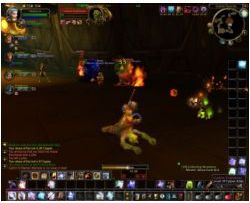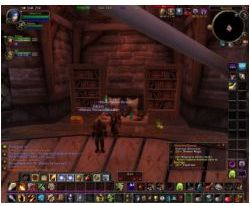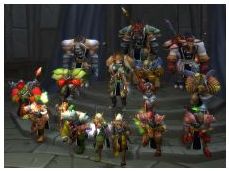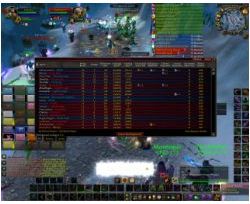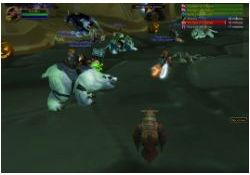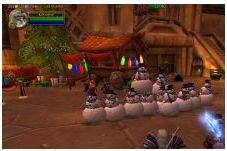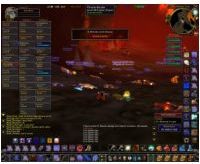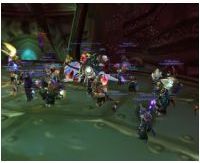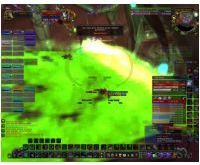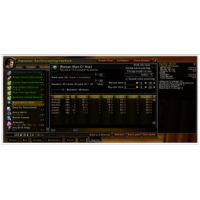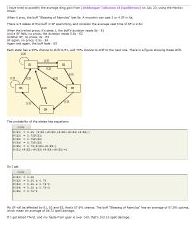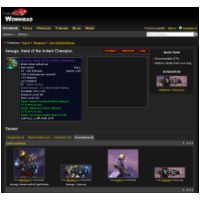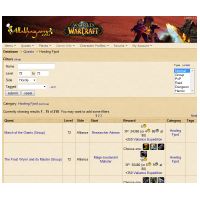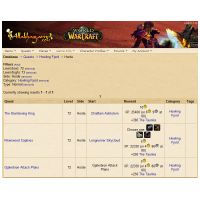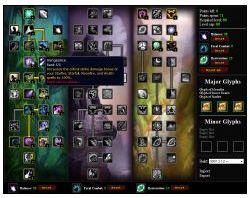The Good
The GoodThe Good, ...
While World of Warcraft is more than just a game, it is still a game at heart. From a gaming point of view, let's first look at what there is for a parent to appreciate about the game.
Easy to Play
The first thing that I usually mention to an older (or the parent of a) potential player, is that WoW is not a first person shooter (FPS), although there are guns - for some classes of players. It's not just another I-kill-you,-you-kill-me or kill-everything-that-moves game. WoW is not a "twitch" driven game at all; that is, it doesn't matter (as much) if your reflexes are less than cat like. WoW is a role-playing game or RPG. That is, you choose an action for your character to perform (after having chosen a target if necessary) and the character acts it out on screen. That action can be hitting something with a club, throwing a lightning bolt, harvesting an herb or any one of hundreds of other actions. (Your character class, level and specialties determine which actions your character can perform. More about this later.)
Because of this, WoW can be played by those younger than would typically be successful at online games like Team Fortress 2 or the latest Call of Duty and just as well by those over the age of 40 whose reflexes may not be quite what they used to be. The oldest player that I regularly played with was in his 60's and retired. He was a dedicated, excellent player. Even so, WoW is not really an appropriate game for children under 12 or 13 to play without nearby adult supervision. There is simulated drinking and some sexual innuendo. The general text chat channel can sometimes be occupied by gamers with a potty mouth (or in this case, potty fingers). The game includes a language filter for chat windows, but it doesn't catch everything. It's nothing a child wouldn't see or hear in many music videos, but then, children under 12 or 13 probably shouldn't be watching those either.
Because of its easy-to-play nature, playing time can double as family time with WoW. Blizzard, the company that developed and owns the World of Warcraft franchise, has no problem with members of the same household playing together. Rather than just watching your children play, you can play the game with them. Playing simultaneously, however, requires multiple accounts and multiple computers which means doubling the monthly fee ($15 - or less) and the cost of the original software (which ranges from $20 to $70 with details to come below). I recommend initially that parents and children create their own characters and take turns on a single account until each players decides if the game is something they want to continue (or want their child to continue). Each account can have up to 50 characters.
Fun to Play
It doesn't matter how easy a game is to play if the game is boring. Tic-tac-toe and the old video game, Pong can be mastered in under an hour, and both get old just as quickly (although I recall Pong seeming like hot stuff when I was young). World of Warcraft is very, very fun. What's more is that even after playing for hours, it stays fun. Blizzard is renowned for creating games that play solidly, with wonderful little details, and are just undeniably fun. The gist of World of Warcraft is to have the player-controlled character complete quests in order to get gold, in-game reward items, and experience (which allows a character to increase in level where new abilities are gained at every level). There are some quests that can get tedious such as gather 10 of these or 20 of those, but the majority are quite fun. Some quests are simply stunning. There are quests that are parodies of Star Trek, the Beatles, old Nintendo games and more. There are also quests that literally change the player's view of the virtual world.
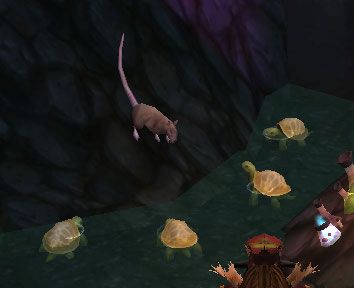
Taken at a leisurely pace, just completing quests and getting a character up to the highest level (85 at the time of this writing) could easily take months if not years. (I've also seen experienced players "level" an "alt" - a second [third or fourth] character in addition to their main character - from level 1 to 85 in 2-3 weeks.) In a talk given by Blizzard executives at the Austin Game Developers Conference (AGDC) in September, 2009, they mentioned that the original WoW (which will allow a character to advance to level 60) has over 2,600 quests. The Burning Crusade expansion (with new areas to explore, new character abilities and a top level of 70) added an additional 2,700 quests and the Wrath of the Lich King expansion (top level of 80) added 2,300 more. There is no way a typical player can or will do all the quests. With some exceptions for quests that are required for every player or required by a certain class of player, if a quest too tedious and boring, the player can drop it and choose another.
This is a good time to mention one thing that sets Blizzard apart from their competitors; Blizzard listens to its subscribers. If a number of players complain a particular quest is too tedious to complete - because the rate at which the necessary items can be obtained is too low, for example - Blizzard can and will increase the rate (or make other changes). They are also very good at investigating and fixing bugs encountered when doing a quest. More recently, Blizzard has taken steps to make leveling easier by dropping the amount of experience required at each level and by increasing the amount of experience gained for most quests. Some areas are slow to travel though without a mount such as a horse, a ram, etc. In order to remove the tedium of having to run long distances, the level at which the first mount can be purchased has been dropped from level 40 when WoW was first released to level 30 later on and is now level 20. The game has other means of transportation for getting around the world quickly, but those don't take one everywhere one needs to go. I mentioned in the intro that my kids played Everquest and Star Wars Galaxies, but I never did. The reason was that I saw how the game often frustrated them. It didn't look like fun to me. Eventually, it caused them to lose interest and quit. Blizzard has done a great job at avoiding those pitfalls and fixing problems as they arise.
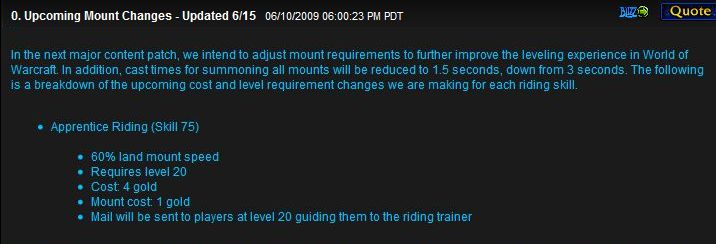
One example of how Blizzard listens to their subscribers in WoW
More Than Just Questing
More Than Just QuestingMore Than Just Questing
One characteristic of Massively Multiplayer Online Role Playing Games (MMORPGs) such as World of Warcraft is the constant community of others. You are never really playing alone. In WoW, players often login just to text chat with friends more or less the same way they use cell phone text messaging. The real fun starts at about level 17. There are special places within the virtual world that players can attempt in a group or party. The party size is 5 for the lower levels, but grows to 10 or even 25 players at the higher levels. A 10 or 25-member party is called a "raid group" or just "raid." The places that a party or raid attempts to conquer are called "dungeons" or "instances." "Instances" is a better term since only a few of the locations are actually dungeons, although most are inside something - a cave, a castle, a mine or a sunken temple for example. These instances have much more difficult enemies, which players at the appropriate level could not defeat alone; they must work together for the common cause. Players also have to defeat one or more bosses along the way that reward players better items than they would get from questing alone. (Click on any of the images with a bluish border to get a larger version.)
In addition to instances, there are also group quests - generally outdoors - that are easier to complete a party of two or three players at the appropriate level. If you have a child joining WoW to play with a few real-life friends, they may have a "built-in" party for doing instances and group quests, but often a group will need to pick up a random individual (with a particular specialty) to complete the group. I made a number of online friends this way and "ran" a number of instances with them later. Some of those instances became my favorite moments in the game. WoW has a way to keep a list of players as friends (as well as a list of players to ignore), which can be used later to tell when those players are logged in. Players can send a private text message to any other player in the game (called a "whisper") in order to ask if they'd like to try an instance run.
As you might expect, getting together a group of 25 people with the proper mixture of abilities to be successful in a larger, more complex instance doesn't happen randomly - at least, not well. Most players at some point will join a guild. A guild is just a group of players that play together regularly under the same guild banner (name). With a guild, there is a special guild text chat. The guild chat is active regardless of where the player is in WoW (unless the player chooses to shut it off or ignore it). Guild chat is a great way to ask questions about a quest that's proving illusive, to ask for or offer help, to organize raid groups for an instance or to just talk about the news of the day. The guild bank is a guild community storage area (found in the larger cities in the game) where members of the guild can place items they find or produce or get items they need. Every guild has one or more guild officers. They can determine who in the guild has what sort of access to which parts of the guild bank. Higher-level players can leave items that up-and-coming players will need for certain quests. It also becomes a storage area for items needed for raids and some rewards from instances.
Guilds are fairly self-policing. While WoW has tools for starting and maintaining a guild roster, the game does nothing to enforce or require a guild. The officers of a guild invite new (un-guilded) players to the guild. They can kick unruly players from a guild as well. A player is free to leave a guild at any time. However, players that wish to successfully advance in the 10 and 25-person instances really need to belong to a guild to do so. Guilds help provide consistency and promote the right mix of other players needed to complete an instance. Most instances require many attempts to work out a successful strategy to defeat the various "bosses." That strategy can only be successful if the players understand it and know each other's play style. A guild has to fairly reward the guild members in order to keep them happy. Players need to play up to their ability and treat guild members well in order to remain in good standing. Defeating a particularly troublesome boss for the first time with 9 or 24 other guild-mates is a particularly euphoric and rewarding experience on par with winning the "big game." The A-Team's Hannibal had it right when he said, "I love it when a plan comes together."
If your child isn't interested in playing in a group, they can play from level 1 to the maximum completely alone. I have done exactly that when I wanted to create an alternate character (called "alts") quickly. They won't be able to go into instances appropriate for their level. They could, if they wished just to see the content, go alone into an instance significantly under their level and generally do just fine. For example, they could go alone into a level 17-20 instance when they are level 40. There are some parts of some instances that require more than one player to advance though. Very few of the items they would receive while in such an instance would be of any use to them (except maybe to sell in the auction house). Such a player should understand that when they reach the top level (called the "level cap"), there won't be much left to do. They could complete outstanding requests or return to do quests they'd not done earlier (even if those quests are significantly under the player's level), do recurring daily quests, play in the battlegrounds and/or arena instances (although that's not done alone). There's really not much else. This isn't necessarily bad because as mentioned before, reaching this point could take months or years. After that, the player could try a new character class as different classes play quite differently. The same quests need to be approached differently by different classes that have different abilities. Also, most classes have special quests for only that class. If a player reaches the point where they feel they've done it all, they can choose to suspend their account. Their characters and all the character's items are placed in limbo. They are no longer able to play nor are they charged the monthly fee. When a new expansion is released later, that player can reactivate their account and start from where they left off.
Some players prefer the player versus player ("PvP") style of play of Call of Duty or Team Fortress 2. Others prefer player against computer-controlled characters, which is called "player versus environment" or "PvE." WoW supports both styles of play. World of Warcraft has two main "factions:" the Alliance and the Horde. As you would find out from the in-game lore, these two factions are sworn enemies. To support the two styles of play, there are two main types of servers: PvE and PvP. On PvE servers, players from opposing factions can only battle in the battlegrounds instances, certain "contested" areas of the world or when both explicitly decide to battle (almost anywhere). On PvP servers, any player can battle any opposing faction player (at any level) at any time with no warning in most areas of the world. Battlegrounds are special instances where a 10, 15 or 40 players from each faction (at or near the same level) battle each other. Some instances are won by conquering the other side's general. Others are capture-the-flag instances and in some, the players must control certain spots in the instances for the most time.
For those players that prefer a rated and laddered set of battles, WoW has an arena system, where two teams of a five players per team battle it out. Arena challenges are divided by "seasons," much like football or baseball. The teams have to be arranged and registered before their first arena match and more-or-less remain constant for the entire season. Based on a team's arena rating, they have access to buy special equipment - which is generally tailored to further PvP play.
Apart from the usual quests, Blizzard has a number of special events in WoW that are held every year. Many correspond to (but are not named the same as) popular holidays from various cultures such as Hallows End (Halloween) and Brewfest (Octoberfest). During these events, there are special quests that have rewards unique to that holiday (such as a special mount like a flying broom, the Headless Horseman's horse or brewfest RAM or a special pet.) Many of these rewards can be very helpful to players in other parts of the game. Some, such as the pet pumpkin, are purely whimsical. There is also a weekly fishing derby, the Stranglethorn Fishing Extravaganza. There are unique rewards from that as well. Very occasionally, Blizzard will also have one-time-only events. These often correspond to the imminent release of a new expansion pack and serve to bridge the lore from the existing world to the new content in the expansion. Even though they may happen only once, they are implemented with the same care that Blizzard shows throughout the game.
Unexpected Real-World Lessons
Unexpected Real-World LessonsUnexpected Real-World Lessons
If as a parent, you lament that the time your child will spend playing WoW is a waste of time, that's not going to be entirely true. Any game - golf, bowling, checkers or computer games - is just a form of entertainment like watching television. However, World of Warcraft does manage to sneak in some things that are reasonably educational. Interestingly, they are actually mostly fun.
Playing On a Team
If your child ends up joining a guild (as discussed before) and progresses to the later levels of the game, they will discover the importance of playing on a team, taking direction & criticism and paying attention. The higher-level encounters - especially the 25-man instances - require a lot of coordination and talent to win. There are instances that every member must survive and do their job in order to succeed. Every member of the group needs to know their primary role and what to do in contingencies. Every member has to start the raid with all the items they need for the session such as potions and (special) equipment. I played organized sports in high school, and I can attest that the need to practice and learn group coordination is no less important when playing WoW. There are no spectators in a raid group and nobody sits on the bench.
Economics
The first of the sneakily educational activities that new players are likely to encounter is the auction house. This is the WoW equivalent of Craig's List or eBay. There is an auction house is located in most major cities. There, players can buy and sell goods they created, harvested and found during questing or running instances. Some items that are auctioned will be used by other players directly (e.g., health potions or armor) or as a part of other things they make or need for quests (e.g., a gold bar or a truesilver rod).
Items are auctioned off using a couple of different auction formats: open-ended and those with a buy-out price. All auctions expire a set time after they are created, but the seller has a choice of a few different periods. The longer the item is listed, the higher the auction house listing fee. The auction house also gets a cut of the sales. Once the player puts an item up for auction, they are free to go off and do other things. If an item in the auction house sells, the seller is notified both by in-game mail (which has the winning amount attached) and in their chat window. If it does not sell, the item is returned to them in the mail. When a player bids on an item in the auction house, they may buy it outright (if the auction has a buyout price) or they can also bid less than the buyout price (and higher than the current bid) hoping to win. Potential buyers are also then free to go off and do other things. If the auction is near closing, however, they may wish to stay in the auction house in case a bidding war occurs. If a user wins an item or is outbid, they are notified by the in-game mail system. If they win, the item is also included in the mail. If they are outbid, their bid amount is returned to them in the mail.
The tools included with the game for using the auction house are good, but another nice feature World of Warcraft offers is an extendable user interface. That is, players can install add-ons (generally written by other players) that make actions they do easier or track those actions. Find one of the many add-ons for tracking the items you see at your local auction house. Several of these create a local database of the prices it sees at that moment. Over time, repeatedly allowing this add-on to scan the auction house will give the player a good idea of the maximum and minimum prices for the items that have been seen. This is one of the most downloaded and used add-ons in the game. There is also a website, WoWuction that is dedicated to tracking the prices of auctions for all the servers in the game. Everyone, once they get to level 20 or so, will need to deal with the auction house for some items. Because of Blizzard's way of making what could be tedious instead be fun and easy, players find this diversion at least a little entertaining.
It's very common to see complaints in the general and guild chat text about spot shortages of an item that has caused a drastic price increase or a glut of some items they are selling, which causes them to sell for much less than they typically do. WoW players, regardless of their age, will learn the finer points of supply and demand in action. Don't be surprised when your child tells you they need to get on for just 15 minutes to check or start an auction. There are certain times of the day and certain days of the week when items sell for more or less than other days, and players will learn when these times occur for the items they sell or seek. Buy low; sell high is alive and well in WoW.
Mathematics & Online Research
Starting at level 10 and continuing as they level, players are awarded one "talent" point per level. There are many more talents than there are points to put into them. Some talents are offensive like a new spell or attack. Some are defensive. Others are more passive to aid in offense or defense. Added to this, there is armor, weapons, shields (for some players), rings, necklaces and other items that can be used to boost a player's talents or reduce an opponent's effectiveness. Additionally, there are magical enhancements and some items have slots for magical gems that can further supplement a player's talents. Suffice it to say, there are dozens of ways any player can beef themselves up.
While it won't be necessary for the early levels, eventually every player begins to wonder if they are getting all they can out of their characters. Perhaps they've noticed another player of the same class doing noticeably more (or less) damage than they are (assuming they are a damage-dealing class) or the other players have a talent they didn't choose to put talent points in themselves. When this happens, the player usually turns to one of the many online websites dedicated to discussing their class and the game mechanics in general. One of my favorites, when I played, was the forums at Elitist Jerks (which seems to have since disappeared).
My (last) main character was a damage spell caster. At Elitist Jerks, I found discussions in the forums that get very spirited with both theoretical and empirical test results by players when they do X, Y and Z instead of Y, X and Z. The math can get pretty involved. I used to use a spreadsheet written for my specific character class that had pull-down menus and fill-in-the-blank boxes that compared various combinations of talents, equipment and spells to maximize my character's ability with alternatives and recommendations. Such spreadsheets are often well above the amateur-Excel-jockey level. However, it's since been replaced with the much more extensive SimulationCraft, which is a C++ program that simulates the damage done by individuals and the raid group as a whole. People take this game seriously because it is no mere game. Nobody thinks anything of an avid golfer spending a week researching a new putter or a fantasy football manager spending 5-6 hours a week computing player stats. The same thing holds true for dedicated WoW players. A player that's serious about making their character perform their best will do the research to see what they need to add or subtract in the way of attack (or defensive) abilities, equipment and play tactics. This type of research can be done to maximize every class, but what that means to each class can be very different.
There is no shortage of websites to aid the player in their research. Some sites, like the Armory, were created by Blizzard themselves. The armory is a searchable database of the players in the game and shows the equipment they have, the talent choices they have made, their achievements and so on. It's a good site for looking at what another player may be doing that seems to be giving them a little more oomph. Other sites, like Elitist Jerks, are run by WoW fans and players. One of the best of those is Wowhead, which is a database of all the items in the game (past and present) and includes all that item's capabilities. The search criteria for Wowhead is very extensive, so once a player determines what they need to add to bolster their character's statistics, they can find out what items with those attributes exist (if any) and how they can obtain them. One of my favorite sites for finding quests or hints about quests is Allakhazam. It helps for finding quests appropriate for a given level or in the area where a player is in or wants to go. It also has hints on where to find items needed for a quest.
Just to add more variables to the mix, every class has three specialties. For example, depending on how I placed my talent points, the class I played could be a healer, a physical attacker, or a (ranged) damage spell caster. At various times in the game, I played the physical attack specialty and the damage spell caster specialty. Every time a player changes specialties, they must pay with some in-game gold to do so. The cost increases each time but hits a maximum. Recently, Blizzard added features to WoW so that players can toggle between two specialties relatively painlessly and cheaply. Of course, each specialty has a different set of attributes (armor, weapons, enchantments, etc.) to achieve to maximize that specialty and requires different research. WoW allows up to ten characters per server and a total of 50 characters per account. If a player decides they picked the "wrong" class for them, is getting bored with their current class or just wants to try a new class, it's simple to start a new character. Blizzard changes some class abilities over time (especially when a new expansion is released) in an attempt to balance how that character plays with or against each other. Because of this, sometimes new research is required even if the player doesn't change characters.
Other sites exist that have strategy guides for leveling different classes, making money with certain professions and how-to guides for defeating instance bosses. Of course, there's more than one way to beat most bosses, so the guides are just a starting point. Every raid group will need to make adjustments to take into account their level of equipment, their play styles, and group composition. There are many YouTube videos on the topic of boss battles. When you have 12 million players or so, there's bound to be a lot of fan support. It's almost guaranteed that a WoW player will at some time use the Internet to research their character and/or how to advance in the game. Doing this type of research is good practice for researching that famous character for an English report, that obscure law for government class or which stocks to invest in.
